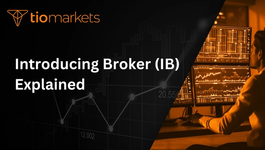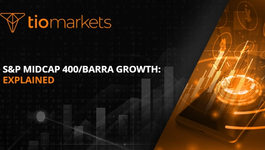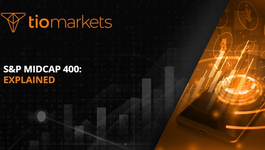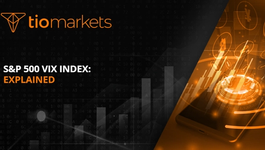Bias ratio: Explained | TIOmarkets
BY TIOmarkets
|July 1, 2024The Bias Ratio is a fundamental concept in the world of trading, particularly in the realm of forex trading. This term is often used to describe the ratio of bullish to bearish traders in the market. Understanding the Bias Ratio can provide traders with valuable insights into market sentiment, which can in turn help inform trading strategies and decisions.
Despite its importance, the Bias Ratio is often misunderstood or overlooked by novice traders. This article aims to demystify the Bias Ratio, providing a comprehensive and detailed explanation of what it is, how it's calculated, and how it can be used in trading. We'll also explore the various factors that can influence the Bias Ratio, and discuss some of the potential pitfalls and limitations of this metric.
Understanding the Bias Ratio
The Bias Ratio is essentially a measure of market sentiment. In other words, it's a way of gaiving an indication of the overall mood of traders in the market. This can be particularly useful in forex trading, where understanding market sentiment can be key to predicting future price movements.
The Bias Ratio is calculated by dividing the number of bullish traders by the number of bearish traders. A Bias Ratio of 1 would indicate a balanced market, with an equal number of bullish and bearish traders. A Bias Ratio greater than 1 would indicate a bullish market, with more bullish traders than bearish traders. Conversely, a Bias Ratio less than 1 would indicate a bearish market, with more bearish traders than bullish traders.
Calculating the Bias Ratio
Calculating the Bias Ratio is a relatively straightforward process. The first step is to determine the number of bullish and bearish traders in the market. This can be done by analyzing trading data, such as the number of long and short positions in the market.
Once the number of bullish and bearish traders has been determined, the Bias Ratio can be calculated by simply dividing the number of bullish traders by the number of bearish traders. This will yield a ratio that can be used to gauge market sentiment.
Interpreting the Bias Ratio
Interpreting the Bias Ratio can be a bit more complex. As mentioned earlier, a Bias Ratio of 1 indicates a balanced market, while a Bias Ratio greater than 1 indicates a bullish market and a Bias Ratio less than 1 indicates a bearish market. However, it's important to note that these are just general guidelines, and the Bias Ratio should always be interpreted in the context of other market indicators and factors.
For example, a high Bias Ratio might indicate a bullish market, but if other indicators are showing signs of a potential market reversal, it might be wise to take a more cautious approach. Similarly, a low Bias Ratio might indicate a bearish market, but if other indicators are suggesting a potential uptrend, it might be a good idea to consider going long.
The Role of the Bias Ratio in Trading
The Bias Ratio can play a crucial role in trading, particularly in forex trading. By providing a measure of market sentiment, the Bias Ratio can help traders predict future price movements, inform trading strategies, and manage risk.
For example, if the Bias Ratio is high and other indicators are also suggesting a bullish market, a trader might decide to go long on a particular currency pair. Conversely, if the Bias Ratio is low and other indicators are suggesting a bearish market, a trader might decide to go short. In this way, the Bias Ratio can provide valuable insights that can help traders make more informed trading decisions.
Using the Bias Ratio in Trading Strategies
The Bias Ratio can be used in a variety of trading strategies. For example, some traders might use the Bias Ratio as a contrarian indicator, going against the prevailing market sentiment in anticipation of a market reversal. Others might use the Bias Ratio in conjunction with other indicators to confirm a trend or signal a potential trading opportunity.
Regardless of how it's used, the Bias Ratio can provide valuable insights into market sentiment, which can in turn help inform trading strategies and decisions. However, it's important to remember that the Bias Ratio is just one tool in a trader's toolkit, and should always be used in conjunction with other indicators and tools.
Managing Risk with the Bias Ratio
The Bias Ratio can also be used to help manage risk in trading. By providing a measure of market sentiment, the Bias Ratio can help traders gauge the potential risk of a trade. For example, if the Bias Ratio is high and a trader is considering going short, they might decide to reduce their position size or use stop-loss orders to limit their potential losses.
Similarly, if the Bias Ratio is low and a trader is considering going long, they might decide to increase their position size or use take-profit orders to maximize their potential gains. In this way, the Bias Ratio can provide valuable insights that can help traders manage risk and optimize their trading performance.
Factors Influencing the Bias Ratio
There are many factors that can influence the Bias Ratio. These can include economic indicators, geopolitical events, market news, and trader psychology, among others. Understanding these factors can help traders interpret the Bias Ratio and use it more effectively in their trading.
For example, economic indicators such as GDP growth, inflation rates, and employment data can have a significant impact on market sentiment, and thus on the Bias Ratio. Similarly, geopolitical events such as elections, wars, and trade disputes can also influence market sentiment and the Bias Ratio. Market news, such as earnings reports and product announcements, can also have an impact on the Bias Ratio.
Economic Indicators and the Bias Ratio
Economic indicators can have a significant impact on the Bias Ratio. For example, strong GDP growth, low inflation rates, and high employment rates can boost market sentiment, leading to a higher Bias Ratio. Conversely, weak GDP growth, high inflation rates, and low employment rates can dampen market sentiment, leading to a lower Bias Ratio.
Traders can use economic indicators to anticipate changes in the Bias Ratio and adjust their trading strategies accordingly. For example, if a country's GDP growth is expected to be strong, traders might anticipate a higher Bias Ratio and adjust their trading strategies to take advantage of this. Conversely, if a country's GDP growth is expected to be weak, traders might anticipate a lower Bias Ratio and adjust their trading strategies to mitigate this.
Geopolitical Events and the Bias Ratio
Geopolitical events can also have a significant impact on the Bias Ratio. For example, elections, wars, and trade disputes can create uncertainty in the market, which can in turn influence market sentiment and the Bias Ratio. Traders can use geopolitical events to anticipate changes in the Bias Ratio and adjust their trading strategies accordingly.
For example, if a major election is approaching, traders might anticipate increased market uncertainty and a lower Bias Ratio. They might then adjust their trading strategies to mitigate this, such as by reducing their position size or using stop-loss orders. Conversely, if a major trade dispute is resolved, traders might anticipate increased market certainty and a higher Bias Ratio. They might then adjust their trading strategies to take advantage of this, such as by increasing their position size or using take-profit orders.
Limitations of the Bias Ratio
While the Bias Ratio can provide valuable insights into market sentiment, it's important to be aware of its limitations. One of the main limitations of the Bias Ratio is that it's a lagging indicator. This means that it reflects past market sentiment, not current or future market sentiment. As a result, the Bias Ratio can be slow to react to changes in the market, which can limit its usefulness in fast-moving markets.
Another limitation of the Bias Ratio is that it's a relative measure, not an absolute measure. This means that it measures the ratio of bullish to bearish traders, not the absolute number of bullish or bearish traders. As a result, the Bias Ratio can be influenced by changes in the total number of traders in the market, which can distort its readings.
The Bias Ratio as a Lagging Indicator
As a lagging indicator, the Bias Ratio reflects past market sentiment, not current or future market sentiment. This can limit its usefulness in fast-moving markets, where market sentiment can change rapidly. For example, if the market suddenly turns bearish, the Bias Ratio might not reflect this change until after it has occurred.
However, despite this limitation, the Bias Ratio can still provide valuable insights into market sentiment. By providing a historical perspective on market sentiment, the Bias Ratio can help traders identify trends and patterns in the market, which can in turn inform their trading strategies and decisions.
The Bias Ratio as a Relative Measure
As a relative measure, the Bias Ratio measures the ratio of bullish to bearish traders, not the absolute number of bullish or bearish traders. This can distort its readings, particularly in markets with a small number of traders. For example, if the number of traders in the market suddenly increases, the Bias Ratio might show a bullish market, even if the absolute number of bearish traders has also increased.
Despite this limitation, the Bias Ratio can still provide valuable insights into market sentiment. By providing a relative measure of bullish to bearish traders, the Bias Ratio can help traders gauge the overall mood of the market, which can in turn inform their trading strategies and decisions.
Conclusion
In conclusion, the Bias Ratio is a fundamental concept in the world of trading, particularly in forex trading. By providing a measure of market sentiment, the Bias Ratio can provide valuable insights that can help traders predict future price movements, inform trading strategies, and manage risk. However, like all trading tools, the Bias Ratio has its limitations, and should always be used in conjunction with other indicators and tools.
By understanding the Bias Ratio, its uses, and its limitations, traders can enhance their trading performance and make more informed trading decisions. Whether you're a novice trader looking to understand the basics, or a seasoned trader looking to refine your strategies, understanding the Bias Ratio is a crucial step in your trading journey.
Ready to Apply Your Knowledge of Bias Ratio?
Now that you're equipped with the insights on Bias Ratio and how it can influence your trading strategies, it's time to put that knowledge into action with TIOmarkets. As a top rated forex broker, we offer you the opportunity to trade over 300 instruments across 5 markets, all with low fees. Join our community of 170,000+ traders in over 170 countries and take advantage of our comprehensive educational resources to further sharpen your trading skills. Don't miss out on the chance to elevate your trading experience. Create a Trading Account today and start your journey towards successful trading.

Risk disclaimer: CFDs are complex instruments and come with a high risk of losing money rapidly due to leverage. You should consider whether you understand how CFDs work and whether you can afford to take the high risk of losing your money. Never deposit more than you are prepared to lose. Professional client’s losses can exceed their deposit. Please see our risk warning policy and seek independent professional advice if you do not fully understand. This information is not directed or intended for distribution to or use by residents of certain countries/jurisdictions including, but not limited to, USA & OFAC. The Company holds the right to alter the aforementioned list of countries at its own discretion.
Join us on social media

Behind every blog post lies the combined experience of the people working at TIOmarkets. We are a team of dedicated industry professionals and financial markets enthusiasts committed to providing you with trading education and financial markets commentary. Our goal is to help empower you with the knowledge you need to trade in the markets effectively.





